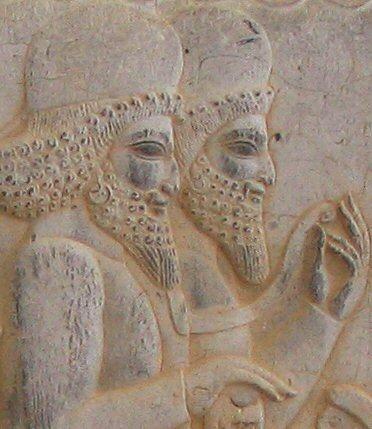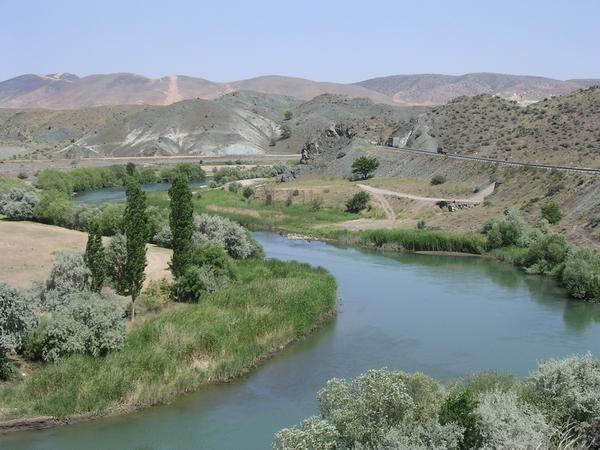Cyaxares
Cyaxares (Persian Uvakhšatara, Akkadian Umakištar): name of a king of the Medes, who may have reigned from c.625 to c.585.

The only account of the reign of Cyaxares can be found in the first book of the Histories by the Greek researcher Herodotus (c.480-c.429). He writes that the Median leader Phraortes
was succeeded by his son Cyaxares, grandson of Deioces. This prince had a far greater military reputation than his father or grandfather. It was he who first organized the Asiatic armies by dividing them into separate units - spearmen, archers, and cavalry. Previously the different arms had all been mixed up in a mob. [...] It was he who united all Asia beyond the Halys under his rule.
The first act of his reign was to march against [the Assyrian capital] Nineveh at the head of all his subject nations, with the object of destroying the town and avenging his father [who had been killed during a campaign against the Assyrians]. He fought a successful battle against the Assyrians, but while he was besieging the town he was attacked by a large Scythian army under the command of king Madyas, son of Protothyes. [...] A battle was fought, in which the Medes were defeated and lost their power in Asia, which was taken over in its entirety by the Scythians.note
The reign of the Scythians in Asia was to last twenty-eight years, according to Herodotus. This is very unlikely; the Scythians were nomads from modern Ukraine and although they were fierce warriors, they were incapable of ruling large territories for a long period. This does not mean that the Scythian invasion is unhistorical; Herodotus tells that they reached Ascalon in Palestine, where the Egyptian pharaoh Psammetichus I (664-610) bribed them to turn back. There is nothing implausible about this story, except for the duration of the Scythian invasion (which will be explained below.)
At last Cyaxares and the Medes invited the greater number of the Scythians to a banquet, at which they made them drunk and murdered them, and in this way recovered their former power and dominion. They captured Nineveh [...] and subdued the Assyrians. [...] Then Cyaxares died, after a reign [...] of forty years. He was succeeded by his son Astyages.note
We possess a cuneiform text about the final days of the Assyrian empire. According to this Fall of Nineveh Chronicle, Cyaxares (called Umakištar) destroyed the Assyrian religious center Aššur in the summer of 614.
The Medes went along the Tigris and encamped against Aššur. They did battle against the city and destroyed it. They inflicted a terrible defeat upon a great people, plundered and sacked them. The king of Babylonia and his army, who had gone to help the Medes, did not reach the battle in time.
From this moment on, Cyaxares and the Babylonian king Nabopolassar joined forces. The Babylonian historian Berossus (third century BCE) writes that the alliance was cemented by a marriage: the Babylonian crown prince Nebuchadnezzar married Amytis, the daughter of Cyaxares' son Astyages. This is impossible (Astyages was too young); probably, Amytis was a daughter of Cyaxares himself. Two years later, Nineveh was captured by the two armies:
The king of Babylonia mustered his army and marched to [lacuna]. The king of the Medes marched towards the king of Babylonia. They met one another. The king of Babylonia and Cyaxares [...] encamped against Nineveh. From the month Simanu [May/June] until the month Âbu [July/August] -for three months- they subjected the city to a heavy siege. On the [lacuna] day of the month Abu they inflicted a major defeat upon a great people. At that time Sin-šar-iškun, king of Assyria, died. They carried off the vast booty of the city and the temple and turned the city into a ruin heap. [...] On the twentieth day of the month Ulûlu [10 August 612] Cyaxares and his army went home.

In the first fragment of this article (above), Herodotus tells us that "it was Astyages who united all Asia beyond the Halys under his rule." The reality behind this remark must be that the Persians, Armenians, Parthians, and Arians all paid tribute to the Medes. Their vassal kings were called "satraps" (khšaçapavan, "protectors of the realm"). Only the conquest of Armenia can be dated: it took place after 609 and probably before 605.
The growth of the Median power worried king Alyattes of Lydia, a kingdom in the west of modern Turkey. Herodotus writes that there was a diplomatic incident in which some Scythians were involved, and continues:
War continued for five years, during which both Lydians and Medes won a number of victories. On one occasion they had an unexpected battle in the dark, an event which occurred after five years of indecisive warfare: the two armies had already engaged and the fight was in progress, when the day was suddenly turned into night. This change of daylight into darkness had been foretold to the Ionians by Thales of Miletus, who fixed the date for it in the year in which it did, in fact, take place.
Both Lydians and Medes broke off the engagement when they saw this darkening of the day; they were more anxious than they had been to conclude peace, and a reconciliation was brought about by Syennesis, a Cilician, and Labynetus of Babylon, who were the men responsible both for the pact to keep the peace and for the exchange of marriages between the two kingdoms. They persuaded Alyattes to give his daughter Aryenis to Astyages, son of Cyaxares - knowing that treaties seldom remain intact without powerful sanctions.note
Syennesis was the title of the king of Cilicia; the Labynetus mentioned in this fragment probably is the later king of Babylon, Nabonidus (ruled 556-539). The solar eclipse can be dated to 28 May 585 BCE.
It may be noted that this battle took place in the twenty-eighth year after the fall of Nineveh. It is likely that Herodotus' statement that the Scythians ruled Asia for twenty-eight years is derived from confusion of two pieces of information: a Scythian raid during the war against Assyria and the diplomatic incident that led to the war between the Medes and the Lydians.
All in all, we can be certain about three events during Cyaxares' reign: the destruction of Aššur in the summer 614, the capture of Nineveh in July 612, and the battle against the Medes on 28 May 585.
This fits neatly into the chronological framework of Herodotus' Histories, where we read that Cyaxares reigned for forty years and his son Astyages for thirty-five. We know for certain that Astyages was defeated by the Persian king Cyrus the Great in the sixth year of his Babylonian colleague Nabonidus, i.e., between 10 March 550 and 28 March 549. Counting backward, we arrive at 625/624 to 585/584 as the regnal years of Cyaxares. This suggests that Cyaxares died almost immediately after the battle against the Lydians.
Under Cyaxares, the Median empire reached its greatest extent, but under his son Astyages, it was destroyed. When in 522 BCE a Mede with the name Phraortes and a Sagartian named Tritantaechmes revolted against the Persian king Darius I the Great, they both claimed to be a descendant of Cyaxares, even though the great king was dead for more than sixty years.